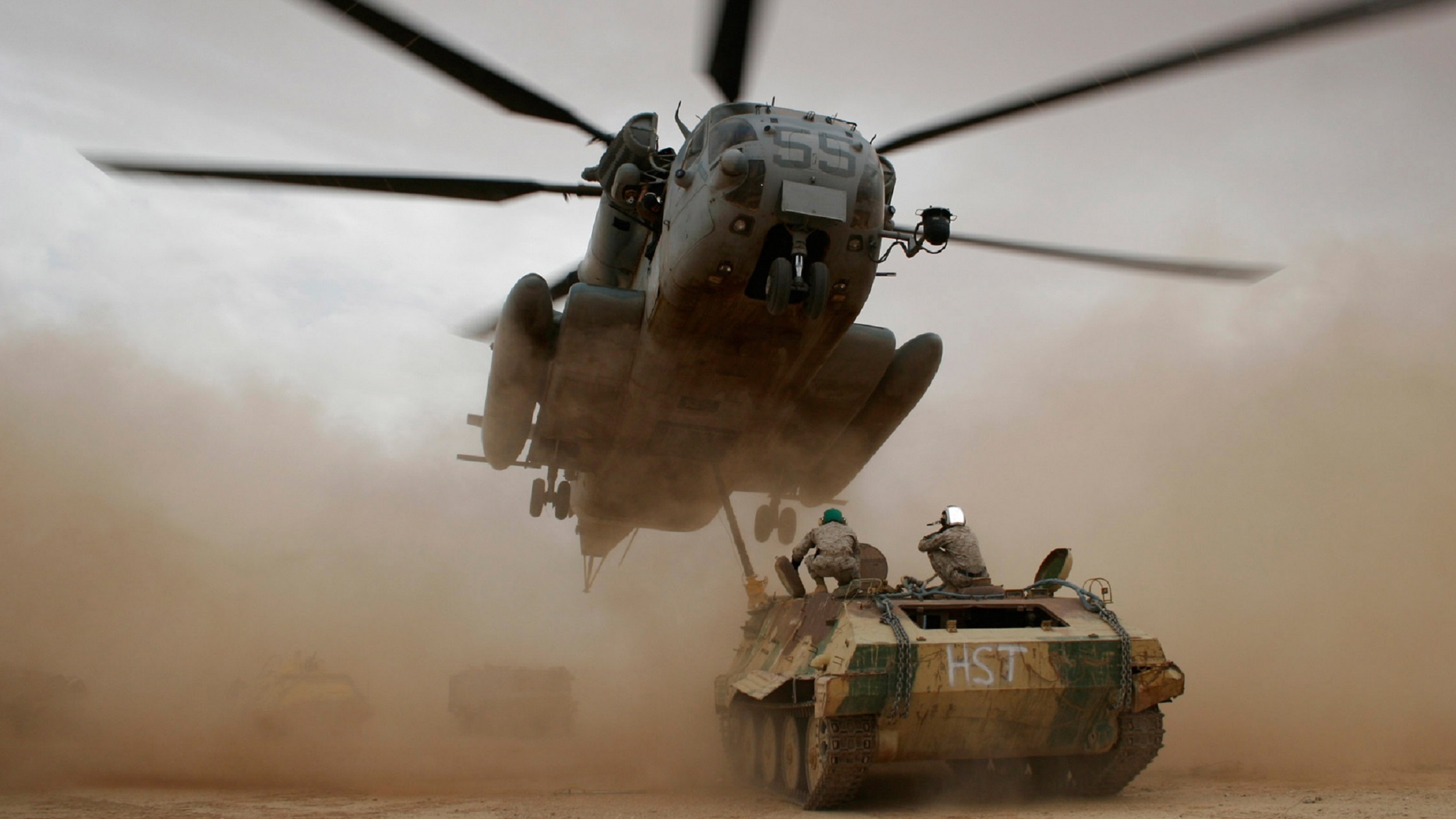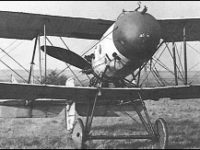The Vickers F.B.12 was a British biplane specially designed for a particular engine, but hardly ever got beyond its experimental status.
Development and design:
At the beginning of the First World War, Vickers established a partnership with the Hart Engine Company to equip future Vickers aircraft with a 150 hp Hart 9-cylinder radial engine.
The first development of the partnership was F.B.12. This aircraft continued to use the outdated principle of the pusher engine. This was located behind the cockpit at the end of a steel construction, whereby the pilot was enclosed by a steel tube.
As with most other aircraft, the rounded wings were made of wood and covered with fabric.
The aircraft was armed with a forward facing Lewis machine gun, with only the tube looking out of the steel tube.
As the Hart engine was not yet available at the time the prototype was completed, it was equipped with an 80 hp Le Rhône engine. The first flight in June 1916, however, showed that the engine used was far too weak for this aircraft. The engine was then replaced with the 100 hp Gnome Monosoupape engine and the wings were enlarged. The aircraft, now classified as Vickers F.B.12A, was sent to France for further testing in December 1916 after exchange and conversion. There it was called by the pilots as a good airplane, however, its achievements were not sufficient against the modern German fighter pilots, so that a front employment was rejected.
Back in Great Britain the engine could be exchanged against the now available 150 HP Hart engine. Under the designation Vickers F.B.12B the first flight took place at the beginning of 1917. In the meantime, despite the rejection of the pilots, the British Ministry of Defence had placed an order for 50 airplanes. With some modifications this was classified as Vickers F.B.12C.
After the crash of the Vickers F.B.12C, the company ended the partnership with the Hart Engine Company and began to deliver the Vickers F.B.12C with different engines. Of the 50 aircraft ordered, only 18 were built.
The last prototype of the Vickers F.B.12 was the Vickers F.B.12D, which was powered by a 110 hp Le Rhone engine and some other modifications. This variant was given up however fast again.
Use in the First World War:
Of the 18 aircraft built, only one was delivered to the Royal Flying Corps and served until the end of the war in Great Britain to defend against German bombers.
Technical data:
| Designation: | Vickers F.B.12 |
| Country: | Great Britain |
| Type: | Fighter |
| Length: | 6,55 meters |
| Span: | 7,93 meters |
| Height: | 2,64 meters |
| Weight: | 580 kg empty |
| Crew: | Max. 1 |
| Engine: | Mainly a Gnome Monosoupape 9-cylinder rotary engine with 100 HP (75 kW) |
| Maximum speed: | 138 km/h |
| Range: | Max. 3 hours |
| Arming: | 1 x 7,7 mm Lewis machine gun |
You can find the right literature here:
The First Air War, 1914-1918
In this concise study, Kennett tells the complete story of World War I's air battles, from Eastern to Western front, from the skies of Europe and its seas to those of the Middle East and Africa.
Aircraft of World War I 1914-1918 (Essential Identification Guide)
Illustrated with detailed artworks of combat aircraft and their markings, Aircraft of World War I: The Essential Aircraft Identification Guide is a comprehensive study of the aircraft that fought in the Great War of 1914–18. Arranged chronologically by theatre of war and campaign, this book offers a complete organizational breakdown of the units on all the fronts, including the Eastern and Italian Fronts. Each campaign includes a compact history of the role and impact of aircraft on the course of the conflict, as well as orders of battle, lists of commanders and campaign aces such as Manfred von Richtofen, Eddie Rickenbacker, Albert Ball and many more. Every type of aircraft is featured, including the numerous variations and types of well- known models, such as the Fokker Dr.I, the Sopwith Camel and the SPAD SVII, through to lesser-known aircraft, such as the Rumpler C.1, and the Amstrong Whitworth FK8. Each aircraft profile is accompanied by exhaustive specifications, as well as details of individual and unit markings. Packed with more than 200 color profiles of every major type of combat aircraft from the era, Aircraft of World War I 1914–1918 is an essential reference guide for modellers, military historians and aircraft enthusiasts.
World War One Aircraft Carrier Pioneer: The Story and Diaries of Captain JM McCleery RNAS/RAF

World War One Aircraft Carrier Pioneer: The Story and Diaries of Captain JM McCleery RNAS/RAF Hardcover – June 13, 2011
Jack McCleery was born in Belfast in 1898, the son of a mill owning family. He joined the RNAS in 1916 as a Probationary Flight Officer. During the next ten months he completed his training at Crystal Palace, Eastchurch, Cranwell, Frieston, Calshot and Isle of Grain, flying more than a dozen landplanes, seaplanes and flying boats, gaining his wings as a Flight Sub-Lieutenant. In July 1917 he was posted to the newly commissioning aircraft carrier HMS Furious, which would be based at Scapa Flow and Rosyth. He served in this ship until February 1919, flying Short 184 seaplanes and then Sopwith 1½ Strutters off the deck. He also flew a large number of other types during this time from shore stations at Turnhouse, East Fortune and Donibristle.
He served with important and well-known naval airmen including Dunning, Rutland (of Jutland) and Bell Davies VC. He witnessed Dunning’s first successful landing on a carrier flying a Sopwith Pup in 1917 and his tragic death a few days later. He also witnessed the Tondern raid in 1918, the world’s first carrier strike mission. He took part in more than a dozen sweeps into the North Sea by elements of the Grand Fleet and Battle Cruiser Fleet. He carried out reconnaissance missions off the coast of Denmark, landing in the sea to be picked up by waiting destroyers. He witnessed the surrender of the High Seas Fleet. Promoted to Captain, he acted as temporary CO of F Squadron for a time postwar.
A World War 1 Adventure: The Life and Times of RNAS Bomber Pilot Donald E. Harkness

A World War 1 Adventure: The Life and Times of RNAS Bomber Pilot Donald E. Harkness Paperback – June 25, 2014
A deeply personal and revealing eyewitness narrative of one airman's life as a bomber pilot in England 's RNAS (Royal Naval Air Service) in WWI. It is a true story, an adventure, and a war memoir carefully constructed from Captain Donald E. Harkness's unpublished diaries, letters, sketches and photographs - only recently uncovered nearly a century later - that documented his remarkable experiences and military adventures over England, France and Belgium. The first book written by a highly decorated WWI flyer from New Zealand that captures the "behind the scenes" life of RNAS pilots, as well as the surprises, terrors, traumas, humor, and sheer excitement of an aerial form of combat never before experienced by anyone, anywhere - and only eleven short years after the Wright Brothers historic flight at Kitty Hawk. With a talent for writing, Don begins an epic journey at a major turning point in history when the world is poised at the dawn of flight, and bracing itself for unknown dangers of unprecedented sophistication and savagery. Don's journal reveals unique insights and vivid imagery of another time and experience, to wit: - the terror and devastation of a Zeppelin bombing raid in London - the training regimen of early flying schools, and their serious & comic episodes - the wonder, awe, and poetry of flying aloft in the majestic heavens - vivid bombing raids, plus the raid that earned him the DSC - his crash-landing and capture - working with the underground to help downed pilots evade capture - London's unrestrained exuberance on Armistice Day; . . . and much, much more.
This post is also available in:
 Deutsch (German)
Deutsch (German)  Français (French)
Français (French)  Italiano (Italian)
Italiano (Italian)  简体中文 (Chinese (Simplified))
简体中文 (Chinese (Simplified))  Русский (Russian)
Русский (Russian)  Español (Spanish)
Español (Spanish)  العربية (Arabic)
العربية (Arabic)














